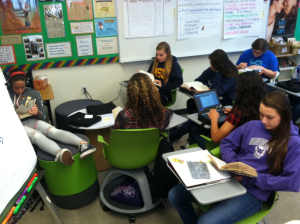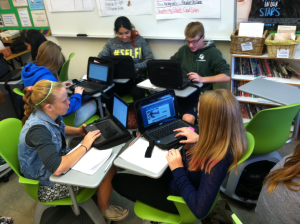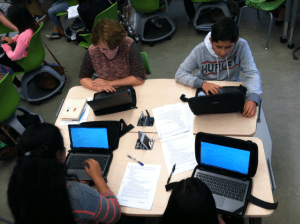Collaboration on Wheels: 21st Century Classroom Furniture at Work
This a follow-up to Collaboration Ottomans? Chairs on Wheels? Which 21st Century Furniture Works for You?

After just one day with our new furniture, I experienced one of those "ah-ha" moments that I'm sure resulted in a light bulb exploding over my head. OK, maybe no visible light bulb, but certainly there were flashes of light in my eyes. As I had predicted when our new furniture first arrived, my students were most enthusiastic about the chairs on wheels, which not only could be maneuvered around the classroom with a light push of the foot, but which also swiveled in place, making it so easy (and fun) to turn to different areas of the classroom, depending on the task. The rolling chairs also have an attached desktop (that swivels, of course!) allowing students to work wherever their rolling takes them.
But we all know that relying on something trendy and cool, like futuristic furniture, won't bring any kind of long-term change to education. After all, how much would this new furniture affect my students' learning if I just lined them up in rows, all students facing front, and taught my class in traditional lecture format (interrupted often with pleas of, "Stop spinning your chairs!")?
No, if our investment in 21st century learning spaces is going to result in meaningful changes for students, we need to pay attention to how new furniture and its arrangement can shake up our expectations of how students should work and what collaboration looks like.
The ah-ha moment came after I had given my students directions for an essay outline they were going to work on that day. I had them all face (or swivel to) the front, and I went over the directions projected on the screen. After a quick check-in, I told them to get to work, and to collaborate with each other if they wanted to. And then the magic happened.

I watched as students started rolling into configurations that appealed to them: partners like Cittlaly and Sara, best friends and a predictable pairing; trios like Matt, Carlos and Eddie, all athletes working on sports-themed essays; mixed-gender groups of kids, like one from the leadership class working on social justice pieces; and a few students who chose to slide off for some solo work. After experimenting a little with the rolling, swiveling and grouping, they settled in to their work.
But it wasn't long before some students started rolling again. Cittlaly swiveled around to slide next to Ellie to ask for help on her outline, then she rolled back to Sara. The leadership kids, chatting longer than the others, started to pull away from their big group to make smaller collaborative groupings. Aaron, working alone in the corner, looked up to find Carlos rolling toward him. Heads together for a few minutes, they exchanged ideas on their essays, and then Carlos slid back over to his group.
And this is when the lightbulb went off: we've been doing collaboration all wrong! All these years, school-style collaboration has gone something like this:
"You four students sitting in these four chairs around this table will collaborate on this particular project from now until the due date. And then you will be done collaborating."
But how much of our adult-world collaboration looks like that? When I collaborate with colleagues, it looks more like this:
Scrolling through my Twitter feed one evening, I find a new app, strategy or project that I'd like to try with my students. I might start by collaborating online with someone on Twitter or Edutopia. Then I'll probably try it out with my students on my own (that's the Lone Ranger in me). At some point I'll bring the idea to a department meeting, where we might collaborate as a group to fine tune it. Or I might talk with just one colleague who has expertise in a certain area. Often I will work with my grade-level teachers in our PLN on a project for all 8th grade students.
In other words, real-world collaboration means that we go to the people we know are the right fit for a particular issue we are facing. And sometimes we work alone. And then we find someone or some people who can help us past the next phase of the project. And we aren't bound by artificial parameters like space or time or numbers of people. And we can work alone when it works for us to work alone.

Since my students are piloting a variety of furniture types, we also have tables and chairs in the classroom, which are grouped in sets of four. I watched those students stay in their groups and collaborate with one another, talking easily around their tables; or some working alone, eyes down, possibly avoiding eye contact with their table peers. Their chairs don't have wheels, which seemed to mean that they weren't allowed to move from their table group to work with other students. While this worked fine for four friends who happened to grab a table together, there was less collaboration going on at the missed-out-on-the-wheelie-chairs and too-late-to-sit-with-friends groups.
Those students at the tables missed out on the real-world fluidity of collaboration. If the students in their group weren't a good match for what they were working on, they worked alone. They watched with envy as their classmates rolled over to work with a variety of students, and it didn't even occur to them to ask me if they could get up out of their stationary chairs and work outside of their table group. You can bet they are counting down the days to their turn to pilot the rolling chairs!
So this past week I have come face-to-face with the pseudo-collaboration that I have been foisting on my students all these years. And it makes me wonder: how can we give our students real-world collaboration opportunities? While the rolling chairs are a huge step in that direction, there's got to be other ways to create the kind of fluid, collaboration-friendly environment for our students that so many of us have in our adult work places. How do you inspire and provide for meaningful collaboration opportunities for your students?
This piece was originally submitted to our community forums by a reader. Due to audience interest, we’ve preserved it. The opinions expressed here are the writer’s own.